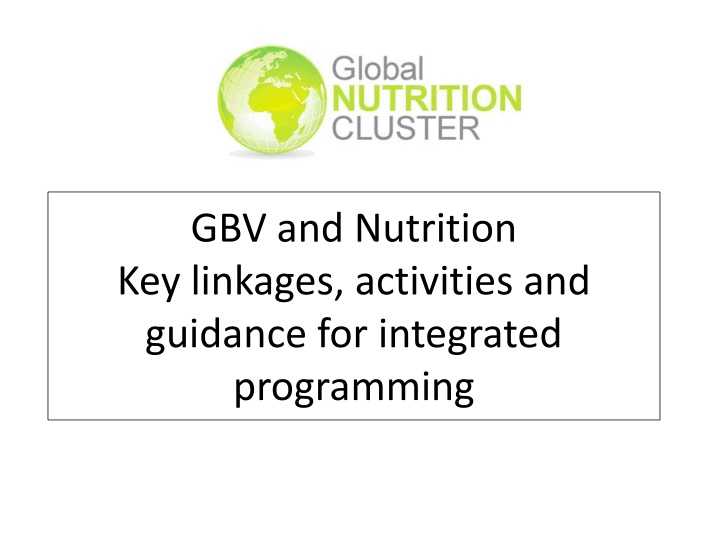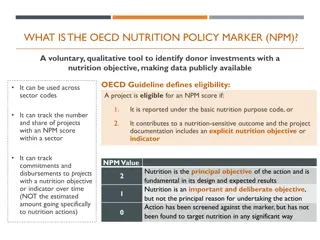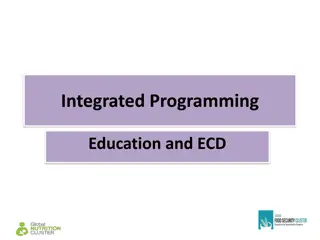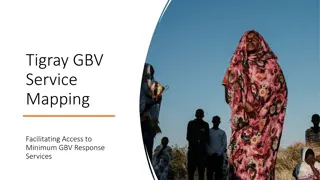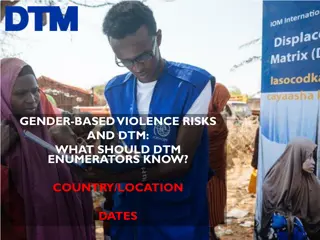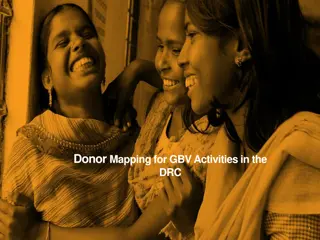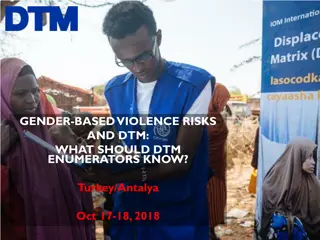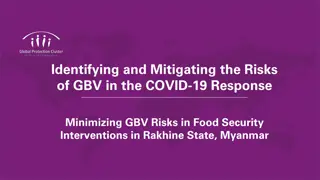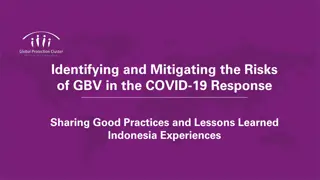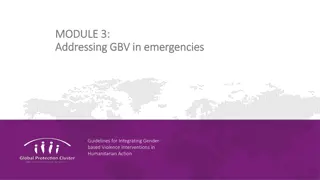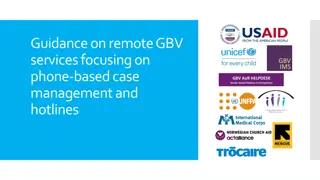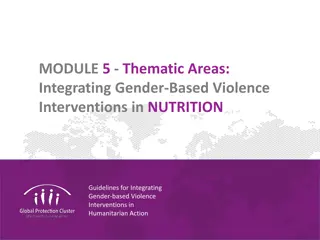Integrating GBV and Nutrition: Key Linkages and Strategies
Gender-based violence (GBV) and nutrition are interconnected, with GBV being a key driver of malnutrition. Integrating GBV into nutrition programs can improve response quality, mitigate malnutrition risks, and reach vulnerable populations effectively. This integration enhances the safety, accessibility, and ethical aspects of nutrition services while empowering women, girls, and at-risk groups. The session focuses on explaining the linkages between GBV and nutrition, identifying integration activities, and promoting survivor-centered approaches.
Download Presentation

Please find below an Image/Link to download the presentation.
The content on the website is provided AS IS for your information and personal use only. It may not be sold, licensed, or shared on other websites without obtaining consent from the author.If you encounter any issues during the download, it is possible that the publisher has removed the file from their server.
You are allowed to download the files provided on this website for personal or commercial use, subject to the condition that they are used lawfully. All files are the property of their respective owners.
The content on the website is provided AS IS for your information and personal use only. It may not be sold, licensed, or shared on other websites without obtaining consent from the author.
E N D
Presentation Transcript
GBV and Nutrition Key linkages, activities and guidance for integrated programming
Session Learning Objectives By the end of this session, participants will: Explain the linkage between GBV and Nutrition. Identify specific activities for the integration of GBV and nutrition interventions
Definition: Gender-based violence Gender-based violence is an umbrella term for any harmful act that is perpetrated against a person s will and is based on socially ascribed (i.e. gender) differences between males and females. It includes acts that inflict physical, sexual or mental harm or suffering, threats of such actions, coercion and other deprivations of liberty. GBV includes rape, sexual violence, physical violence, emotional violence, deprivation of opportunities and services, intimate partner violence etc.
How does GBV integrated Nutrition services look like? Quality, Safe and accessible nutrition services Reach to the most vulnerable populations Safe/dignified access and use of nutrition services Ethical nutrition services/programming Survivor-centered GBV referral GBV integration Safe and meaningful participation of women, girls and other at risk groups throughout the HPC . GBV integration is one of strategies to achieve quality, safe and accessible nutrition services.
Definition GBV integration GBV programming GBV integration = good pragramming By integrating GBV, nutrition programmes can improve quality of nutrition response, mitigate risks of malnutrition, reach to the most vulnerable and prevent and mitigate risks of GBV of the affected population
Linkage between GBV and Nutrition GBV is one of drivers of malnutrition. Gender/power dynamics in the home have major implications for effectiveness of nutrition interventions and uptake of the services. Lack of food as a driver for forced marriage + increased risk of sexual exploitation and abuse. Location and timing of nutrition services/distribution points can increase GBV risk Caregiver s experience of GBV can have negative implications for child nutrition outcomes
Women who experienced any form of IPV were more likely to have stunted children GBV increases the risk of Stunting
Women experiencing any form of IPV during or before pregnancy were more likely to have Low Birth Weight (LBW) children or children who were too small for their gestational age. GBV affects fetal growth and development
GBV Immediate Initiation of Breast Feeding increases the risk of early cessation of breast feeding Mothers who were exposed to IPV had a greater likelihood of feeding their children liquids within 24 hours of birth compared to those who were not. Exclusive Breast Feeding Women who experienced any form of IPV during pregnancy were more likely to stop exclusive breast feeding within 6 months after birth.
Health/Nutrition facilities are too far/in Barriers and Women and girls do not receive information because: limited to community leaders; non-child friendly Common areas where GBV risks are present in Nutrition sector sent enablers a dangerous location. Materials do not cater to the needs of the girls/women Social norms Location of facilities Distribution a long waiting line, overcrowded, lack of female distribution staffs The dissemination of information and awareness The delivery of material support Participation of Women and Girls Not adequate no. of female nutrition frontline workers. Girls , boys, women and other at risk groups are not consulted in assessment, design and M&E systematically. Human Resources gender, skills, attitudes Design/ layout of facilities security, privacy and dignity Nutrition facilities do not reflect the culture or needs of the affected population. Lack of female leaders in Nutrition.
Integrating GBV and Nutrition-How Entry Point! Women and girls themselves Identify GBV risks in the environment and their barriers to accessing services Identify priorities Programmatic entry points Assessment Analysis and Planning Entry Point! Articulate GBV risks related to nutrition response. Include GBV risk mitigation measures. Monitoring and Evaluation Resource Mobilization Entry Point! Monitor GBV risks Safety audit Safety perception SADD Entry Point! Safe and dignified access to services. Ethical programming. Participation Safe and ethical referral Coordination Implementation
Barrier analysis: Availability, Accessibility, Acceptability and Quality (AAAQ framework) Accessibility Physical Accessibility: Location, route, safety, other physical barriers Availability: Is the service available ? Financial Accessibility: User fees, transportation cost. Acceptability: Is the service acceptable to the affected population (M/F different age and abilities) Administrative Accessibility: Civil documents, procedures i.e. mandatory reporting, administrative complication to access the service. Language. Social Accessibility: Social norms ( e.g. women can only talk to women, men has to approve women s access to the service), cultural belief, social exclusion, stigma to access the services etc. Quality: Do service providers possess the necessary skills/training? Are there adequate supplies? Are the facilities safe and sanitary? Quality also extends to the way people are treated before, during and after accessing services. Information Accessibility: availability of the information of the service. Who receive the information, language, style of communications,
Examples - Ethiopia A GBV case worker stays in IYCF centers and provide information on GBV to the users. Any people who want to access GBV services can seek support from the GBV case worker or directly access to services. More women access Women Friendly Space. More survivors of GBV seek support through the case worker. A simple collaboration like this can save life. When women receive adequate care, there is positive effect to nutrition outcome of children and the women.
Examples South Sudan Integrating GBV messages into IYCF card. Nutrition has bigger and different outreach from GBV actors. This integration can disseminate critical message.
Integrating GBV and Nutrition Integrating GBV and Nutrition tools IASC GBV Guidelines IASC GBV Guidelines Thematic Area Guide for Nutrition Thematic Area Guide for Nutrition tools Key consideration to integrate GBV interventions in Education in 5 areas: Assessment, Analysis and Planning Resource mobilization Implementation Coordination M&E Essential Action Sheet Other accompanied resources: Donor advocacy tools Pocket guide how to support survivors of GBV when a GBV actor is not available in your area. www.gbvguidelines.org
Integrating GBV and Nutrition Integrating GBV and Nutrition tools GBV pocket guide and Cash and Voucher Assistance and GBV pocket guide and Cash and Voucher Assistance and GBV compendium GBV compendium tools - Step by step guide for non-GBV specialists Key messages that you can use to the survivor Special consideration for child survivors. Ethiopian version is being developed. - - - Practical guidance on how to mitigate GBV risks in cash and voucher assistance. GBV pocket guide mobile app is available in google play and iTune store. Search GBV pocket guide
Take Home Messages GBV is one of drivers of malnutrition. Nutrition services could exacerbate GBV risks without identifying and addressing GBV risks related to nutrition services. By integrating GBV risk mitigation, nutrition services can improve quality of services & access to services for the most vulnerable. Talk to GBV actors to identify good ways of working/collaboration
